Herbert von Karajan
Herbert von Karajan (German: [ˈhɛɐbɛɐt fɔn ˈkaraˌjan] (![]()
Herbert von Karajan | |
|---|---|
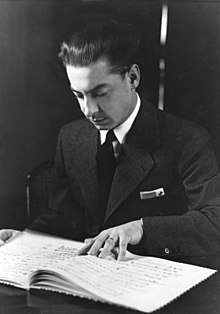 Herbert von Karajan in 1938 | |
| Born | Heribert Ritter von Karajan 5 April 1908 |
| Died | 16 July 1989 (aged 81) Anif, Austria |
| Occupation | Conductor |
| Years active | 1929–1989 |
| Spouse(s) |
|
| Signature | |
 | |
Biography
Early life
Genealogy
_%E2%80%93_Gerd_Hru%C5%A1ka.png)
The Karajans were of Greek Macedonian[4][5][6][7][8][9] ancestry. His great-great-grandfather, Georg Karajan (Geórgios Karajánnis, Greek: Γεώργιος Καραγιάννης), was born in Kozani, in the Ottoman province of Rumelia (now in Greece), leaving for Vienna in 1767, and eventually Chemnitz, Electorate of Saxony.[10]
His last name, like several other Ottoman-era ones, contains the Turkish language prefix 'kara' in reference to someone's dark complexion.
He and his brother participated in the establishment of Saxony's cloth industry, and both were ennobled for their services by Frederick Augustus III on 1 June 1792, thus adding the prefix "von" to the family name. This usage disappeared with the abolition of Austrian nobility after World War I. The surname Karajánnis became Karajan.[11] Although traditional biographers ascribed a Slovak and Serbian or simply a Slavic origin to his mother,[12] Karajan's family from the maternal side, through his grandfather who was born in the village of Mojstrana, Duchy of Carniola (today in Slovenia), was Slovene.[11][12][13] Through this line, Karajan was related to the Austrian composer of Slovene descent Hugo Wolf.[14] Karajan seems to have known some Slovene.[11][12]
Childhood and education

Heribert Ritter von Karajan was born in Salzburg, Austria-Hungary, the second son of senior consultant Ernst von Karajan and Marta née Kosmač.[15][16] He was a child prodigy at the piano.[17] From 1916 to 1926, he studied at the Mozarteum in Salzburg with Franz Ledwinka (piano), Franz Zauer (harmony), and Bernhard Paumgartner (composition and chamber music).[18] He was encouraged to concentrate on conducting by Paumgartner, who detected his exceptional promise in that regard. In 1926 Karajan graduated from the conservatory and continued his studies at the Vienna Academy, studying piano with Josef Hofmann (a teacher with the same name as the pianist) and conducting with Alexander Wunderer and Franz Schalk.[19]
Career
Early engagement
Karajan made his conductor debut in Salzburg on 22 January 1929. The performance brought attention of the general manager of the Stadttheater in Ulm, and eventually led to Karajan's first appointment as assistant Kapellmeister of the theater.[15][16] His senior colleague in Ulm was Otto Schulmann. After Schulmann was forced to leave Germany in 1933 with the NSDAP take-over, Karajan was promoted to first Kapellmeister.
Nazi years
In the postwar era Karajan maintained a silence about his Nazi Party membership which gave rise to a number of conflicting stories regarding it. One version asserts that because of the changing political climate and the destabilization of his position, Karajan attempted to join the Nazi Party in Salzburg in April 1933, though his membership was later declared invalid for he somehow failed to follow up the application[16] and that Karajan formally joined the Nazi Party in Aachen in 1935, implying that he was not eager to pursue membership. More recent scholarship clears up this confusion: "[t]he truth is that Karajan actually joined the Nazi Party twice. The first time this happened was on 8 April 1933 in Salzburg. He paid the admission fee, received the membership number 1607525 and moved to Ulm. It is said that this accession was never formally carried out. It is also certain that Karajan rejoined the Nazi Party in Aachen in March 1935, this time receiving the membership number 3430914. After the annexation of Austria, the responsible Reich Treasurer of the Nazi Party discovered Karajan's double membership in Munich and declared the first accession invalid. The second was made retroactive to 1 May 1933."[20] During the entire Nazi era he "never hesitated to open his concerts with the Nazi favorite "Horst-Wessel-Lied". Karajan "always maintained he joined strictly for career reasons."[21] His career could not have proceeded without interruption without his demonstratively lukewarm membership. His enemies referred to him as "SS Colonel von Karajan".[22]
In 1933 Karajan made his conducting debut at the Salzburg Festival with the Walpurgisnacht Scene in Max Reinhardt's production of Faust. In Salzburg in 1934, Karajan led the Vienna Philharmonic for the first time, and from 1934 to 1941, he was engaged to conduct operatic and symphony-orchestra concerts at the Theater Aachen.
Karajan's career was given a significant boost in 1935 when he was appointed Germany's youngest Generalmusikdirektor and performed as a guest conductor in Bucharest, Brussels, Stockholm, Amsterdam and Paris.[23] In 1938 Karajan made his debut with the Berlin Philharmonic. The same year, he made his debut with the Berlin State Opera conducting Fidelio, and then enjoyed a major success at the State Opera with Tristan und Isolde. His performance was hailed by a Berlin critic as Das Wunder Karajan (the Karajan miracle). The critic asserted that Karajan's "success with [Richard] Wagner's demanding work Tristan und Isolde sets himself alongside [Wilhelm] Furtwängler and Victor de Sabata, the greatest opera conductors in Germany at the present time".[18] Receiving a contract with Deutsche Grammophon that same year, Karajan made the first of numerous recordings, conducting the Staatskapelle Berlin in the overture to The Magic Flute.
World War II
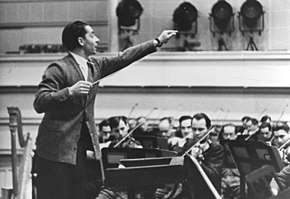
Karajan's career continued to thrive at the beginning of the war. In 1939 the Berlin State Opera appointed Karajan as State Kapellmeister and conductor of symphony concerts by the Prussian State Orchestra.[15] He then became music director of the Staatskapelle Berlin, with which he toured in Rome with extraordinary success.[16] However, in the following year his contract in Aachen was discontinued. His marriage to the partly Jewish Anita Gütermann and the prosecution of his agent Rudolf Vedder also contributed to the temporary professional decline, leaving him few engagements beyond a limited season of concerts with the Staatskapelle.[24]
By 1944, Karajan was, according to his own account, losing favour with the Nazi leadership, but he still conducted concerts in wartime Berlin on 18 February 1945. A short time later, in the closing stages of the war, he and his wife Anita fled Germany for Milan, relocating with the assistance of Victor de Sabata.[16][25]
Karajan's increased prominence from 1933 to 1945 has led to speculation that he joined the Nazi Party solely to advance his music career. Critics such as Jim Svejda[26] have pointed out that other prominent conductors, such as Arturo Toscanini, Otto Klemperer, Erich Kleiber, and Fritz Busch, fled Germany or Italy at the time. Richard Osborne noted that among the many significant conductors who continued to work in Germany throughout the war years—Wilhelm Furtwängler, Carl Schuricht, Karl Böhm, Hans Knappertsbusch, Clemens Krauss and Karl Elmendorff—Karajan was one of the youngest and thus one of the least advanced in his career.[27] Karajan was allowed to conduct various orchestras and was free to travel, even to the Netherlands to conduct the Concertgebouw Orchestra and make recordings there in 1943.[28]
Karajan's denazification tribunal, held in Vienna on 15 March 1946, cleared him of illegal activity during the Nazi period.[24] Karajan was discharged by the Austrian denazification examining board on 18 March 1946, and resumed his conducting career shortly thereafter.[29] Therefore, years later former German Chancellor Helmut Schmidt could say about Karajan's Nazi party membership card: "Karajan was obviously not a Nazi. He was a Mitläufer".[20]
Postwar years
In 1946, Karajan gave his first post-war concert in Vienna with the Vienna Philharmonic, but he was banned from further conducting activities by the Soviet occupation authorities because of his Nazi party membership. That summer he participated anonymously in the Salzburg Festival.
On 28 October 1947, Karajan gave his first public concert following the lifting of the conducting ban. With the Vienna Philharmonic and the Gesellschaft der Musikfreunde, he performed Johannes Brahms' A German Requiem for a gramophone production in Vienna.[30]
In 1949, Karajan became artistic director of the Gesellschaft der Musikfreunde, Vienna. He also conducted at La Scala in Milan. His most prominent activity at this time was recording with the newly formed Philharmonia Orchestra in London, helping to build them into one of the world's finest. Starting from this year, Karajan began his lifelong attendance at the Lucerne Festival.[31]
In 1951 and 1952, he conducted at the Bayreuth Festspielhaus.
Berlin appointment
During their tour of the United States in 1955, Karajan's past membership in the Nazi Party led to the Berlin Philharmonic's concerts being banned in Detroit, while Philadelphia Orchestra music director Eugene Ormandy refused to shake Karajan's hand. Upon arriving in New York City for a concert at Carnegie Hall, Karajan and the Berlin Philharmonic were confronted by protests and picketers.[32] Reviews of the concert that night were enthusiastic and quietened most of the protesters.
In 1956, Karajan was appointed principal conductor for life of the Berlin Philharmonic as successor to Wilhelm Furtwängler.[33]
From 1957 to 1964, he was artistic director of the Vienna State Opera. Karajan was closely involved with the Vienna Philharmonic and the Salzburg Festival, where he initiated the Easter Festival, which would remain tied to the Berlin Philharmonic's Music Director after his tenure.
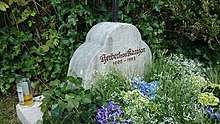
Last years
In his later years, Karajan suffered from heart and back problems, needing surgery on the latter. Karajan resigned as the Principal Conductor of the Berlin Philharmonic on 24 April 1989.[34] His last concert was Bruckner's 7th Symphony with the Vienna Philharmonic. He died of a heart attack at his home in Anif on 16 July 1989 at the age of 81.[2]
Karajan read the works of Father Hugo Enomiya-Lassalle on Zen Buddhism. He became a practitioner of Zen Buddhism. He believed strongly in reincarnation and said that he would like to be reborn as an eagle so he could soar over his beloved Alps.[2] Even so, on 29 June 1985, he conducted Wolfgang Amadeus Mozart's Coronation Mass during a Mass celebrated by John Paul II in St. Peter's Basilica, on the Feast of Sts. Peter and Paul, and received Holy Communion from the hand of the Pope with his wife and daughters.[35] By the end of his life he had reconciled with the Catholic Church, and requested a Catholic burial.[36]
Personal life
Marriages and children
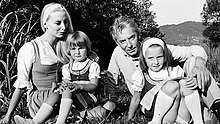
On 26 July 1938, Karajan married Elmy Holgerloef, an operetta singer. He first worked with Elmy on a 1935 New Year's Eve gala production of Strauss's Die Fledermaus. They divorced in 1942. Elmy died of heart failure[37] in 1983. A statement from his Salzburg office stated that Karajan was "very shocked, affected, and deeply upset by the news. He had never forgotten her; she had been a part of his life."[38] Karajan did not, however, attend her funeral in Aachen.
On 22 October 1942, at the height of the Second World War, Karajan married his second wife, Anna Maria "Anita" Sauest, born Gütermann. She was the daughter of a well-known manufacturer of yarn for sewing machines. Having had a Jewish grandfather, she was considered a Vierteljüdin (one-quarter Jewish woman). They divorced in 1958.
On 6 October 1958, Karajan remarried. His third wife was Eliette Mouret, a French model born in Mollans-sur-Ouvèze. She had enjoyed a carefree childhood growing up in Provence before being discovered by Christian Dior when she was just 19 years old. This laid the foundation for an international modelling career. Karajan had first met Mouret in 1957, and was deeply taken with her. Their first daughter, Isabel, was born on 25 June 1960. In 1964, their second daughter, Arabel, was born.
After the death of Herbert von Karajan in July 1989, Eliette von Karajan continued her husband's musical legacy. With the founding of the Herbert von Karajan Centre in Vienna, now situated in Salzburg and known as the Eliette and Herbert von Karajan Institute, she created a cultural memorial dedicated to Karajan that has established itself during the years of its existence as an essential part of the local cultural scene. Her numerous projects, focusing particularly on the development of young people, and her engagement as patron of the Salzburg Easter Festival, mean that Eliette von Karajan is ensuring that her husband's work is still heard long after his death, remaining a living thing for generations to come.[39]
Hobbies
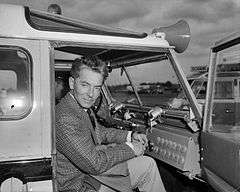

Herbert von Karajan was a passionate sportsman since he was a teenager: a passionate skier and swimmer, he even followed a daily yoga ritual. At sea, Karajan won several regattas aboard his racing yachts baptised Helisara. He piloted his Learjet, and was also great sailing and car enthusiast, in particular an amateur of Porsche.[40]
Karajan put the same meticulous attention to detail that made him a master of Nibelungen productions into the design of his cars. When he contacted the Porsche special order department in 1974 about a new Type 930, he made it absolutely clear that he wanted a lighter and more sports-oriented version of the standard production vehicle. Karajan dictated that the car should weigh less than one thousand kilograms and its power-to-weight ratio should be well under four kilos per hp—no easy task, given that the standard version was already at 1,140 kilos and 260 hp. The Porsche CEO at the time, Ernst Fuhrmann, carried out the special wishes of his prominent customer himself. Karajan's Turbo was given the racing chassis of an RSR and the body of a Carrera RS, along with a racing suspension and rollover bars. The interior was rigorously stripped down. The backseat was replaced by a steel roll cage, while the radio and any symphonies it might have played gave way to the harmonies of the flat-six engine, which could mobilize around 100 more hp thanks to a larger turbocharger and a sharper camshaft. Lightweight construction even extended to replacing the door handles with slim leather straps that opened the catch when pulled. And Porsche specifically requested permission from Rossi, the vermouth producer, to replicate the Martini racing paint job from the 911 Carrera RSR Turbo 2.1 that finished second in the 24 Hours of Le Mans in 1974. The resulting 1975 unique and tailored 911 Turbo model still carries Karajan's name to this day.[41]
Musicianship
One of Karajan's signature skills as a conductor was his ability to extract exquisite sounds from orchestras. His biographer Roger Vaughan observed this phenomenon while listening to the Berlin Philharmonic play in 1986, after nearly 30 years under Karajan's direction, noting that "what rivets one's attention is the beauty and perfection of the sounds. The softest of pianissimos commands rapt attention. The smooth crescendos peak exactly when they should. The breaks are sliced clean, without the slightest ragged edge."[42] This unique talent, together with Karajan's impeccable technique, set him apart as one of the premiere conductors of the Twentieth Century.
Conducting style
Perhaps the most distinctive feature of Karajan's conducting style was his propensity to conduct with his eyes closed. This was, and is, highly unusual for a conductor to do on anything but occasion, as eye-contact is generally regarded as of paramount importance to the conductor's communication with the orchestra's players. Yet, as Vaughan wryly remarks, "[h]ere is one of the fascinating aspects of conducting: there are no rules, only guidelines. The most eccentric approach is tolerated if the results are successful."[43] And there can be no doubt that Karajan was successful and eccentric. Indeed, James Galway, who served as principal flutist of the Berlin Philharmonic from 1969 to 1975, recalled that "he [Karajan] achieved most of what wanted through charm".[44]
Behind many of Karajan's eccentricities though, was a reason. Conducting with his eyes closed, for instance, was a consequence of memorizing scores—with that out of the way, what need he look at?[43] Karajan's method of score study, too, was somewhat unusual, as was noted by his friend Walter Legge, who remarked that "He [Karajan] is one of the few conductors I have known who has never made a mark in a score. He will absorb a score quietly sitting on the floor, like a relaxed Siamese cat. Over the years he has learned how completely to relax the body so the mind is absolutely free to do what it wants."[45] Karajan was also known to have a preternaturally keen sense of tempo, even going so far as to have himself tested against a computer to prove it. He insisted that this skill was learned, not inherited, and considered it the bedrock of musical interpretations. In fact, he cited inconsistencies in rhythmic accuracy and control as "one thing that might make me lose my temper. I can accept a wrong note from an orchestra but when everything is getting faster or slower, that I cannot accept."[46]
He once explained to a German journalist why he preferred the Berlin to the Vienna Philharmonic. "If I tell the Berliners to step forward, they do it. If I tell the Viennese to step forward, they do it. But then they ask why."[47]
Musical tastes
Karajan was a noted interpreter of virtually every standard of the classical repertoire, from the Baroque era through to the twentieth century. He was an admirer of Glenn Gould's interpretations of Bach, even performing the D minor Keyboard Concerto with him on one occasion. The eminent Haydn scholar H. C. Robbins Landon considered Karajan's recordings of the 12 London Symphonies as some of the finest he knew, and his multiple Beethoven cycles are still staples of many a CD collection.[48]
Yet Karajan's real interests seem to have lain in the period from the late-19th to the mid-20th centuries. Principal among these were his fascinations with the composers Anton Bruckner and Jean Sibelius. In an interview with Gramophone's Robert Layton in 1981, Karajan remarked that he felt "a much deeper influence, affinity, kinship – call it what you like – [in Sibelius's music] with Bruckner. There is this sense of the ur-wald, the primaeval forest, the feeling of elemental power, that one is dealing with something profound."[49] When pressed about this connection towards the end of his life by biographer Richard Osborne, Karajan echoed some of these same sentiments, commenting: "There is in both [Bruckner and Sibelius] a sense of the elemental. But I have often asked myself what it is that drew me to Sibelius's music and I think it is that he is a composer who cannot really be compared to anyone else. ... And you never come to an end with him. I think it is perhaps also to do with my love of remote places, my love of mountains rather than cities."[50] Layton demystifies this relationship somewhat by observing that "[s]tring tremolandi and pedal points are, of course, among [the similarities between Bruckner and Sibelius' music], and we hear Brucknerian echoes in the development section of the first movement of Kullervo, written only a year or so after Sibelius first heard Bruckner's Third Symphony in Vienna."[49] Yet the most potent assessment of Karajan's interpretation of Sibelius's music came from Sibelius himself, who, according to record producer Walter Legge, said that "Karajan is the only conductor who plays what I meant."[51]
Karajan was also a prolific opera conductor, championing the works of both Wagner and Verdi, along with the likes of Strauss and Puccini. Verdi's last opera, Falstaff, was something of a mainstay throughout Karajan's career. In his conversations with Richard Osborne, Karajan recalled that, in the 1930s, when Italian opera was still something of a rarity in Austria and Germany, "[m]y training in Verdi's Falstaff came from [Arturo] Toscanini. There wasn't a rehearsal in either Vienna or Salzburg at which I wasn't present. I think I heard about thirty. From Toscanini I learnt the phrasing and the words – always with Italian singers, which was unheard of in Germany then. I don't think I ever opened the score. It was so in my ears, I just knew it."[52] He went on to make two recordings of it – one for EMI in 1956 and another for Philips in 1980 – and his production at the Vienna State Opera was hailed by his colleague Otto Klemperer as "'really excellent.'"[53] Likewise, Richard Strauss was a continual force in Karajan's life, not just as a composer, but as a conductor as well. Karajan regaled their only ‘proper' meeting, in 1939, to Osborne, stating that "at the end [of a performance of Elektra in Berlin] he [Strauss] came and said to me it was the best performance of the opera he had ever heard. I said, 'I don't really want to hear this; tell me what was wrong with it.' I think he was surprised by my reaction, so he asked me to lunch the next day. He said, 'You have made the music very clear, the fp here, the accent there; but these are not at all important. Just wave your stick around a bit!' He made a gesture like stirring a pudding. But what he meant was, let the music flow more naturally."[54]
Use of recording technology
Karajan conducted and recorded prolifically, mainly with the Berlin Philharmonic and the Vienna Philharmonic. Although he conducted other orchestras (including the NHK Symphony Orchestra, the New York Philharmonic, the Concertgebouw Orchestra, the Orchestre de Paris, the Orchestra of Teatro alla Scala, Milan and the Staatskapelle Dresden), the vast majority of his recordings were made with the Berlin and Vienna orchestras with which he was most associated. He also left a considerable legacy of recordings with the Philharmonia Orchestra, his last performance being in 1960.[55]
Although he made recordings with several labels, notably EMI, it is Deutsche Grammophon with which he became most associated. He made 330 recordings with Deutsche Grammophon during his career.[56] Karajan's 1981 recording of An Alpine Symphony by Deutsche Grammophon conducting the Berlin Philharmonic became the first work ever to be pressed on the compact disc format. Even though his repertoire had been extensively covered in analog (LP record), he spent of the rest of that decade making digital recordings; notably re-recording Ludwig van Beethoven's nine symphonies (Karajan and the Berlin Philharmonic's 1977 analog recording of Beethoven's Symphony No. 3 won the Grand Prix du Disque, while their 1984 digital recording of the same piece was not particularly critically acclaimed yet sold for considerably more). In the early 2000s, Deutsche Grammophon sold the Karajan Masters re-release of Karajan's 1980s digital recordings that had been further enhanced by 24-bit processing.
Critical reception
The so-called ‘Karajan sound' which so distinguished his style as a conductor remains something of a litmus test for critics, dividing them into two competing camps. Two reviews from the Penguin Guide to Compact Discs illustrate this point:
- Concerning a recording of Wagner's Tristan und Isolde (1971–72 studio recording), a canonical Romantic work, the Penguin authors wrote, "Karajan's is a sensual performance of Wagner's masterpiece, caressingly beautiful and with superbly refined playing from the Berlin Philharmonic".[57]
- About Karajan's recording of Haydn's "Paris" symphonies, the same authors wrote, "big-band Haydn with a vengeance ... It goes without saying that the quality of the orchestral playing is superb. However, these are heavy-handed accounts, closer to Imperial Berlin than to Paris ... the Minuets are very slow indeed ... These performances are too charmless and wanting in grace to be whole-heartedly recommended."[58]
The New York Times writer John Rockwell wrote in 1989: "He had a particular gift for Wagner and above all for [Anton] Bruckner, whose music he conducted with sovereign command and elevated feeling."[2]
Legacy
During his life, Karajan's concerts became viewed as major cultural events. In a tour to the United States in 1982, his Carnegie Hall concerts were attended by musical stars from Zubin Mehta and Seiji Ozawa through to Frank Sinatra.[59] Karajan was not interested in publicity or legacy so much as building the cultural institution of music. "When I am on the podium, I forget all about the public," he said. "I am not interested in publicity. I can only hope there is an advantage to my being known in the world, that through the interest people take in me, they will then move on to an interest in music."[60]
Much of Karajan's legacy is inextricable from his pioneering attitude towards recording technology. He created over 800 recordings during his career, far surpassing the output of other contemporary conductors. Deutsche Grammophon, the West German record company that shared him with EMI, said his albums sold ''probably hundreds of millions'' of copies. Der Spiegel, the West German newsweekly, reported that he earned more than $6 million annually from record sales and conducting fees in 1989. Karajan amassed a fortune valued at 250 million euros as of 2008, remaining one of top-selling classical music artists two decades after his death.[2][61]
Notable students
Despite Karajan's significant prowess as a conductor, he was more often seen behind the camera than in the teaching studio, preferring to record rehearsals rather than give masterclasses. He maintained a long friendship with Seiji Ozawa whose success makes him Karajan's most reputable student.[62] Indeed, Ozawa was reportedly a strong contender to succeed Karajan with the Berlin Philharmonic; Karajan specifically mentioned him as a "conductor with the best character" for the position.[63][59]
Awards and honours
Karajan was the recipient of multiple honours and awards. He became a Grand Officer of the Order of Merit of the Italian Republic on 17 May 1960,[64] and in 1961 he received the Austrian Medal for Science and Art. He also received the Grand Merit Cross (Grosses Bundesverdienstkreuz) of the Order of Merit of the Federal Republic of Germany.
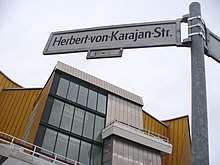
In 1977 he was awarded the Ernst von Siemens Music Prize. On 21 June 1978 he received the honorary degree of Doctor of Music from Oxford University.[65] He was honored with Médaille de Vermeil from the Académie française in Paris,[66] the Gold Medal of the Royal Philharmonic Society in London,[67] the Olympia Award of the Onassis Foundation[68] and the UNESCO International Music Prize.[69] He received two Gramophone Awards for recordings of Mahler's Ninth Symphony and the complete Parsifal recordings in 1981. He received the Eduard Rhein Ring of Honor from the German Eduard Rhein Foundation in 1984.[70] He was voted into the inaugural Gramophone Hall of Fame in 2012.[71] He has received the Picasso Medal from UNESCO.
From 2003 to 2015, the Festspielhaus Baden-Baden awarded the annual Herbert von Karajan Music Prize in recognition of excellence in musical achievements.[72] In 2003 Anne-Sophie Mutter, who had made her debut with Karajan in 1977, became the first recipient of this award. Since 2015 the music award has been replaced by the Herbert von Karajan Prize presented at the Salzburg Easter Festival.[73]
Karajan was an honorary citizen of Salzburg (1968), Berlin (1973), and Vienna (1978). His legacy is managed since 2005 by the Eliette and Herbert von Karajan Institute.
Grammy Awards
Karajan's multiple Grammy Awards make him a particularly prominent conductor historically; his career spanned 40 Grammy nominations across nearly 30 years. Karajan was a three-time Grammy Award recipient, having won Best Opera Recording award for Bizet's Carmen in 1964 and Wagner's Siegfried in 1969, and the Best Classical Orchestral Performance for a Beethoven symphony cycle in 1978.[74] Karajan's Beethoven cycles remain some of the most popular and enduring in record collections worldwide, as well as the most critically acclaimed recordings of the past century.[75][76]
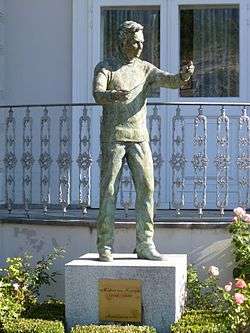
Monuments
Even after his death in 1989, Karajan has remained a visible part of everyday-life in the cities he once called home, thanks in part to the monuments that have been erected in his honor. In Salzburg, for instance, the Karajan Foundation of Vienna commissioned the Czech artist Anna Chromý to create of life-sized statue of the conductor which now stands outside his birthplace.[77]
In February 1983, a bronze bust of Karajan was unveiled in the foyer of the newly built State Theatre in Berlin.
In popular culture
Two of Karajan's interpretations were popularized through their inclusion in the soundtrack for the film 2001: A Space Odyssey. Most famously, the version of Johann Strauss' The Blue Danube which is heard during the film's early outer space scenes is that of Karajan conducting the Berlin Philharmonic. Secondly, the version of Richard Strauss' Also Sprach Zarathustra which is used in the film is that of Karajan conducting the Vienna Philharmonic.[78][lower-alpha 1]
Selected discography
Receiving a contract with Deutsche Grammophon in 1938[79] Karajan was notably fastidious for his studious perfectionism when creating hundreds of symphonic recordings, as well as numerous opera recordings by Verdi and Puccini, in particular those with Maria Callas.[80] Highlights of Karajan's recordings with the Berlin Philharmonic include Richard Strauss' Also Sprach Zarathustra, Wagner's Der Ring Des Nibelungen, and Mahler's Symphony No. 5.
During Karajan's lifetime, the public often associated him with the works of Beethoven. Karajan recorded four complete Beethoven symphony cycles,[81] first with the Philharmonia Orchestra for Angel in 1951 to 1955,[82] and then three times with the Berlin Philharmonic Orchestra for Deutsche Grammophon in 1961/62,[83] 1975/76,[84] and from 1982 to 1984.[85]
Among 20th-century musical works, Karajan had a preference for conducting and recording works from the first half of the century, by such composers as Mahler, Schoenberg, Berg, Webern, Bartók, Sibelius, Richard Strauss, Puccini, Honegger, Prokofiev, Debussy, Ravel, Hindemith, Nielsen and Stravinsky. Performances of works written post-1950 included Shostakovich's Tenth Symphony, written in 1953, which he performed many times and recorded twice. He and Shostakovich met during a tour with the Berlin Philharmonic culminating in Moscow in May 1969[86] and Karajan had stated in an interview with the German TV-channel ZDF in 1983 that if he had been a composer instead of conductor, his music would have sounded similar to Shostakovich's. Karajan conducted the Berlin Philharmonic in Hans Werner Henze's Sonata per Archi (1958) and Antifone (1960). In 1960 he performed Ildebrando Pizzetti's opera Assassinio nella cattedrale written two years before. Karajan premiered Carl Orff's De temporum fine comoedia in 1973 with the Cologne Radio Symphony Orchestra and recorded the work for Deutsche Grammophon.
See also
Notes
- Although Karajan's version of Zarathustra is the one which is actually used in the film, the original soundtrack release instead used a different version not conducted by Karajan; later re-issues of the soundtrack restored Karajan's version.
References
- Regarding personal names: Ritter is a title, translated approximately as Sir (denoting a Knight), not a first or middle name. There is no equivalent female form.
- John Rockwell (17 July 1989). "Herbert von Karajan Is Dead; Musical Perfectionist was 81". The New York Times. pp. A1.
- Lebrecht, Norman (2007). The Life and Death of Classical Music: Featuring the 100 Best and 20 Worst Recordings Ever Made. Knopf Doubleday. p. 137. ISBN 9780307487469.
- Cramer, Alfred W. (2009). Musicians and Composers of the 20th Century. 3. Salem Press. p. 758. ISBN 9781587655159.
Herbert Ritter von Karajan (fahn KAHR-eh-yahn) was born to Ernst and Martha von Karajan, an upper-class family of Greek-Macedonian origin.
- Robinson, Paul; Surtees, Bruce (1976). Karajan. Macdonald and Janes. p. 6.
Herbert von Karajan was born in Salzburg 5 April 1908. Though an Austrian by birth, the Karajan family was actually Greek, the original surname being Karajanis or "Black John". The family had migrated from Greece to Chemnitz, Germany, and from there to Austria about four generations before Herbert.
- Brunskill, Ian (2010). The Times Great Lives: A Century In Obituaries. HarperCollins UK. ISBN 9780007363735.
Born in Salzburg on 5 April 1908, Karajan was the younger son of a distinguished surgeon and his Slovenian wife. Originally called Karajannis, the Karajan family were Macedonian Greeks who had moved first to Saxony and later to Vienna, where they held important academic, medical, and administrative posts.
- Metropolitan Opera Guild (1961). (a piece giving biographical information on Karajan). Opera News. 26. Metropolitan Opera Guild. p. 397. OCLC 1590631.
The thirty-five-year career began when Karajan was nineteen. He had been born on 5 April 1908, into a family of Greek ancestry that enjoyed considerable prestige in the Austro-Hungarian Empire.
- Kuhn, Laura Diane (1999). Baker's Student Encyclopedia of Music: H–Q. Schirmer Books. p. 850. ISBN 9780028654164.
Karajan, Herbert von [...] cultured family of Greek-Macedonian extraction whose original name was Karajannis. His father was a medical officer.
- Kater, Michael H. (1997). The Twisted Muse: Musicians and Their Music in the Third Reich. Oxford University Press. p. 56. ISBN 9780195096200.
Karajan was born in 1908 in Austrian Salzburg, the son of a well-to-do physician of partially Greek-Macedonian ancestry whose forebears had been ennobled while in the service of the Saxon kings.
- John Rockwell (22 June 1986). "General Music Director of Europe". The New York Times. Retrieved 15 April 2007.
- "Herbert von Karajan-Karajan Family". Karajan Family. Retrieved 14 March 2012.
- Lapajne, Branka (4 April 2008). "The Shared Slovenian Ancestors of Herbert von Karajan and Hugo Wolf". Retrieved 5 May 2008.
- Matheopoulos, Helena (1983). Maestro: encounters with conductors of today. Harper & Row. p. 244. ISBN 978-0-06-015103-4.
- Lapajne, Branka (2006). "Hugo Wolf in Herbert von Karajan: potomca družine Lavtižar" [Hugo Wolf and Herbert von Karajan: The Descendants of the Lavtižar Family] (PDF). Bilten [Bulletin] (in Slovenian). Slovensko muzikološko društvo [Slovenian Musicological Society]. 24: 31–34. Archived from the original (PDF) on 6 December 2013.
- "Herbert von Karajan – His Life". www.karajan.org. Retrieved 27 September 2019.
- Osborne 2000, p.
- Herbert von Karajan at the Encyclopædia Britannica
- Osborne 2000, p. 18
- Artist Biography by David Brensilver, retrieved 31 May 2014
- Kammholz, Karsten (26 January 2008). "Der Mann, der zweimal in die NSDAP eintrat" [The Man Who Joined the NSDAP Twice]. Die Welt (in German). Retrieved 27 March 2020.
Zu Lebzeiten wollte sich der Stardirigent nie der Tatsache stellen, Mitglied der NSDAP gewesen zu sein. Bis heute gilt er vielen als bloßer Mitläufer. Dabei zeigen historische Dokumente: Gleich zwei Mal trat er in die Partei ein und nutzte sie bewusst für seine Karriere. [During his lifetime, the star conductor never wanted to face up to the fact that he had been a member of the Nazi Party. To this day, he is regarded by many as a mere follower. Historical documents show that he joined the party twice and deliberately used it for his career.]
- Vaughan 1985, p. 11.
- Saunders, Frances Stonor (1999). The Cultural Cold War: The CIA and the World of Arts and Letters. New York City: The New Press. p. 13–14. ISBN 978-1-59558-914-9.
- Wagner concert at the Palais de Chaillot, Paris, 6 June 1941] (the woman in the footage is Winifred Wagner.
- Brunner, Gerhard; Charles Barber, and José A. Bowen. "Karajan, Herbert von". Grove Music Online. Accessed 27 September 2019. https://www-oxfordmusiconline-com.proxy1.library.jhu.edu/grovemusic/view/10.1093/gmo/9781561592630.001.0001/omo-9781561592630-e-0000014696
- Andrews, Deborah (1990). The Annual Obituary, 1989. St James Press. p. 417. ISBN 1-55862-056-7.
- Radio Program on Nazi-Era Musicians: Part 4 of 4, retrieved 28 September 2019
- Osborne 2000, p. 85
- "Herbert von Karajan – The First Recordings". Deutsche Grammophon. Retrieved 5 December 2016.
- Osborne 2000; Karajan's deposition is presented in whole as Appendix C.
- Steinhage, Martin (1986). Chronik 1947 (in German). Dortmund, Germany: Harenberg Verlag. p. 178. ISBN 3-88379-077-X.
- Karajan Celebration 2008. lucernefestival.ch
- "Herbert von Karajan's Symphonic Obsessions" by Tom Huizenga, NPR, 4 April 2008
- "The era of Herbert von Karajan". www.berliner-philharmoniker.de. Retrieved 29 September 2016.
- Schmemann, Serge (25 April 1989). "Karajan Leaves Berlin Philharmonic". The New York Times. Retrieved 29 September 2016.
- Mozart: Coronation Mass / Karajan, Vienna Philharmonic Orchestra. St. Peter's Basilica on YouTube
- Osborne 2000, p. 729: "Karajan believed that we have different lives, possibly in metamorphosis. As far as the here and now was concerned, however, he was Catholic; and had requested a Catholic burial. Years previously, he had purchased a modest burial plot in Anif churchyard."
- Osborne 2000, p. 667: "In February 1983, a bronze bust of Karajan was unveiled in the foyer of the new State Theatre. Two months later, during the night of 17 April, Karajan's first wife Elmy Karajan-Holgerloef died of heart failure."
- Aachener Nachrichten, 20 April 1983 (listed at Osborne 2000, p. 818
- "Eliette Mouret – Biography". eliette-von-karajan.org.
- Siep, Lena (25 October 2017). "Karajan's unique Porsche". Porsche Newsroom. Retrieved 30 September 2019.
- Vaughan 1985, p. 14.
- Vaughan 1985, p. 19
- Vaughan 1985, p. 22.
- von Karajan 1989, p. 95.
- von Karajan 1989, p. 96.
- Norman Lebrecht, The Book of Musical Anecdotes, the Free Press, New York, 1985 p. 326
- Service, Tom (25 November 2009). "HC Robbins Landon provided a passport to Mozart's world". The Guardian. ISSN 0261-3077. Retrieved 30 September 2019.
- Gramophone (21 July 2015). "Karajan's Sibelius". www.gramophone.co.uk. Retrieved 30 September 2019.
- von Karajan 1989, p. 107.
- von Karajan 1989, p. 108.
- von Karajan 1989, pp. 68–69.
- von Karajan 1989, p. 68.
- von Karajan 1989, pp. 111–112.
- "Herbert Von Karajan – Orchestras". www.karajan.co.uk. Retrieved 30 September 2019.
- "How the CD was developed", BBC News; accessed 3 March 2009.
- Penguin Guide to Compact Discs; 2005. Penguin Books. ISBN 0141022620. p. 1477.
- The Penguin Guide to Compact Discs and Cassettes. Penguin Books. 1996. pp. 576. ISBN 9780140513677.
- Tuck, Lon (27 October 1982). "The Majestic Reach of Karajan". The Washington Post. ISSN 0190-8286. Retrieved 26 September 2019.
- Holland, Bernard (22 October 1982). "How Von Karajan Sees His Conducting Success". The New York Times. ISSN 0362-4331. Retrieved 26 September 2019.
- Scott-Stokes, Henry (15 November 1981). "2 Maestros, Pupil and Sensei, in Japan". The New York Times. ISSN 0362-4331. Retrieved 26 September 2019.
- "After Karajan, a Cloudy Crystal Ball". The New York Times. AP. 9 July 1987. ISSN 0362-4331. Retrieved 26 September 2019.
- "von Karajan Maestro Herbert" (in Italian). Presidency of the Italian Republic. Archived from the original on 5 March 2016. Retrieved 19 November 2012.
- LAP. "Herbert von Karajan – Visits to Great Britain". Karajan.co.uk. Retrieved 21 August 2011.
- "Herbert von Karajan – A Chronology". Deutsche Grammophon. Archived from the original on 6 September 2015. Retrieved 28 September 2015.
- "Gold Medal Recipients Since 1870 / 1950–1999". Royal Philharmonic Society. Royal Philharmonic Society. Archived from the original on 3 January 2015. Retrieved 15 March 2015.
- "Onassis International Prizes". Alexander S. Onassis Public Benefit Foundation. Retrieved 15 March 2015.
- "Prize laureates 1975–2004". International Music Council. Retrieved 15 March 2015.
- "The Eduard Rhein Ring of Honor Recipients". Eduard Rhein Foundation. Archived from the original on 18 July 2011. Retrieved 5 February 2011.
- "Herbert von Karajan (conductor)". Gramophone. Retrieved 10 April 2012.
- "Herbert von Karajan Musicprize". Festspielhaus Baden-Baden. Archived from the original on 10 August 2017. Retrieved 15 March 2015.
- "Herbert von Karajan Prize established in Salzburg" (PDF). Osterfestspiele Salzburg (Press release). 7 October 2015. Retrieved 20 August 2018.
- "Herbert von Karajan". Grammy.com. 4 June 2019. Retrieved 26 September 2019.
- Freed, Richard (18 March 1990). "Recordings; Karajan vs. Karajan vs. Karajan vs. ..." The New York Times. ISSN 0362-4331. Retrieved 26 September 2019.
- "Top 10 Karajan recordings". Gramophone. 10 July 2014. Retrieved 26 September 2019.
- Chromy, Anna. "Herbert von Karajan". Anna Chromy. Retrieved 27 September 2019.
- "Various – 2001: A Space Odyssey (Music from the Motion Picture Sound Track)". Discogs. Retrieved 30 September 2019.
- "Herbert von Karajan – 15 facts about the great conductor". Classic FM (UK). Retrieved 26 September 2019.
- "An interview with Karajan at 80". Gramophone. 1 January 2015. Retrieved 26 September 2019.
- Mordden, Ethan (1986). A Guide to Orchestral Music: The Handbook for Non-musicians. New York: Oxford University Press. p. 56. ISBN 9780195040418.
- https://musicbrainz.org/release/34924327-64df-4202-ab2c-c1e60518ac9a
- https://musicbrainz.org/release/91649373-72ae-4113-917b-e87c4b4a2b5d
- https://musicbrainz.org/release/f972154a-087a-418c-8c1b-600917fcbc9f
- "Release Beethoven – Karajan by Beethoven; Karajan". musicbrainz.org.
- Shostakovich and Karajan photo. karajan.co.uk
Bibliography
- von Karajan, Herbert (1989). Osborne, Richard (ed.). Conversations with von Karajan (1st US ed.). New York: Harper & Row. ISBN 0060391073. OCLC 21042949.
- Osborne, Richard (2000). Herbert von Karajan: A Life in Music. Boston: Northeastern University Press. ISBN 1-55553-425-2.
- Vaughan, Roger (1985). Herbert von Karajan : A Biographical Portrait (1st ed.). New York: W. W. Norton. ISBN 0393022242. OCLC 11814326.
Further reading
- Mischa Aster, "Das Reichsorchester", Die Berliner Philharmoniker und der Nationalsozialismus. Siedler Verlag, 2007, ISBN 978-3-88680-876-2.
- Kleinert, Annemarie (2009). Music at its Best: The Berlin Philharmonic. From Karajan to Rattle. Norderstedt: BoD. ISBN 978-3-8370-6361-5.
- Layton, Robert; Greenfield, Edward; March, Ivan (1996). Penguin Guide to Compact Discs. London; New York: Penguin Books. ISBN 0-14-051367-1.
- Monsaingeon, Bruno (2001). Sviatoslav Richter: Notebooks and Conversations. Princeton University Press. ISBN 0-571-20553-4.
- Osborne, Richard (1998). Herbert von Karajan. London: Chatto & Windus. ISBN 0-7011-6714-9.
- Raymond, Holden (2005). The Virtuoso Conductors. New Haven, Connecticut; London: Yale University Press. ISBN 0-300-09326-8.
- Zignani, Alessandro (2008). Herbert von Karajan. Il Musico perpetuo. Varese: Zecchini Editore. ISBN 978-88-87203-67-7.
External links
| Wikimedia Commons has media related to Herbert von Karajan. |
| Wikiquote has quotations related to: Herbert von Karajan |
- Official website
- Herbert von Karajan at the Encyclopædia Britannica
- František Sláma: Part2 : Herbert von Karajan – Conductors and a few more recollections besides
- Elaine Madlener Papers: correspondence and notes for an unfinished Karajan biography at Newberry Library
- Interview from 1983 on YouTube, ZDF, in German without subtitles